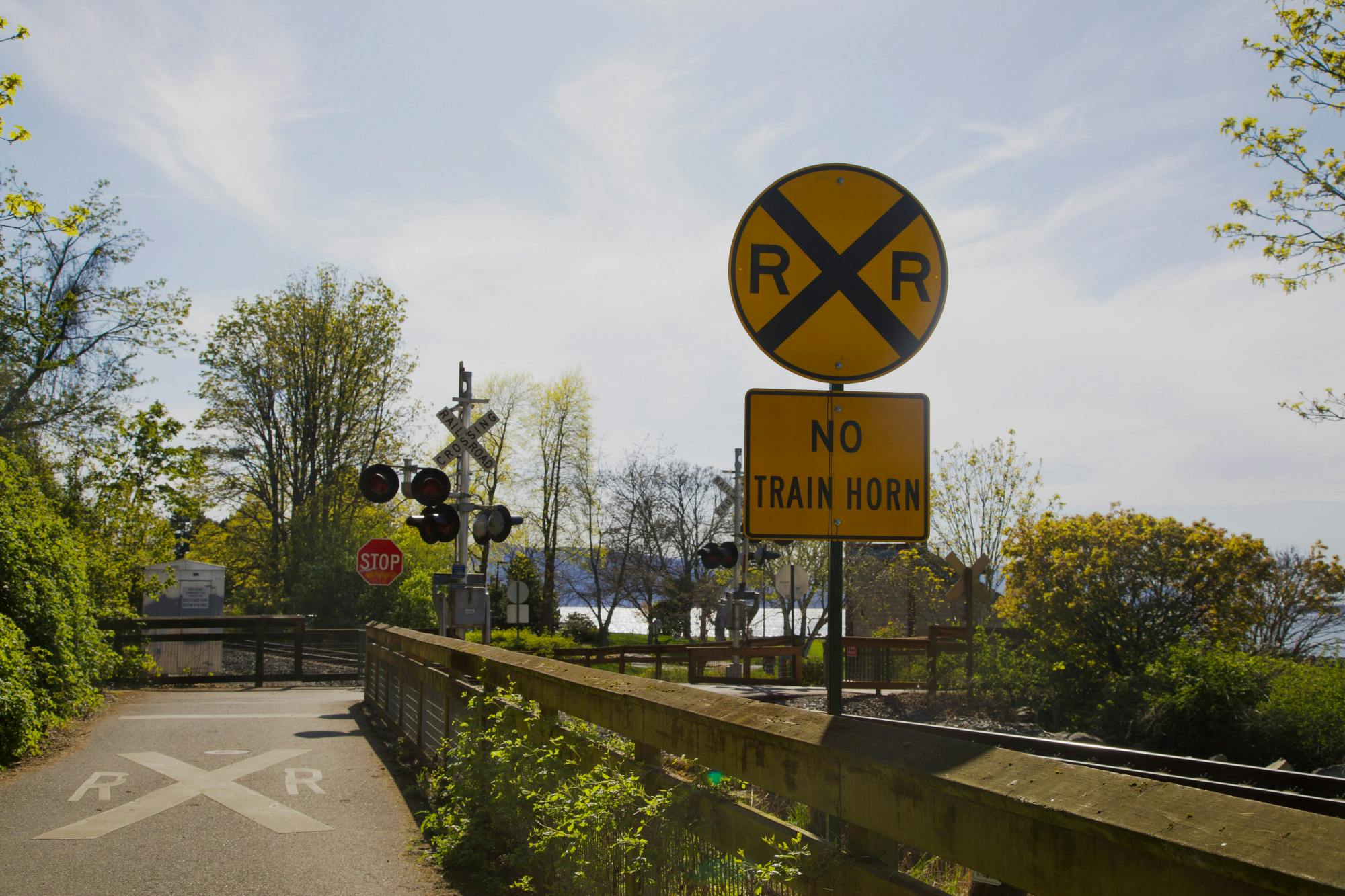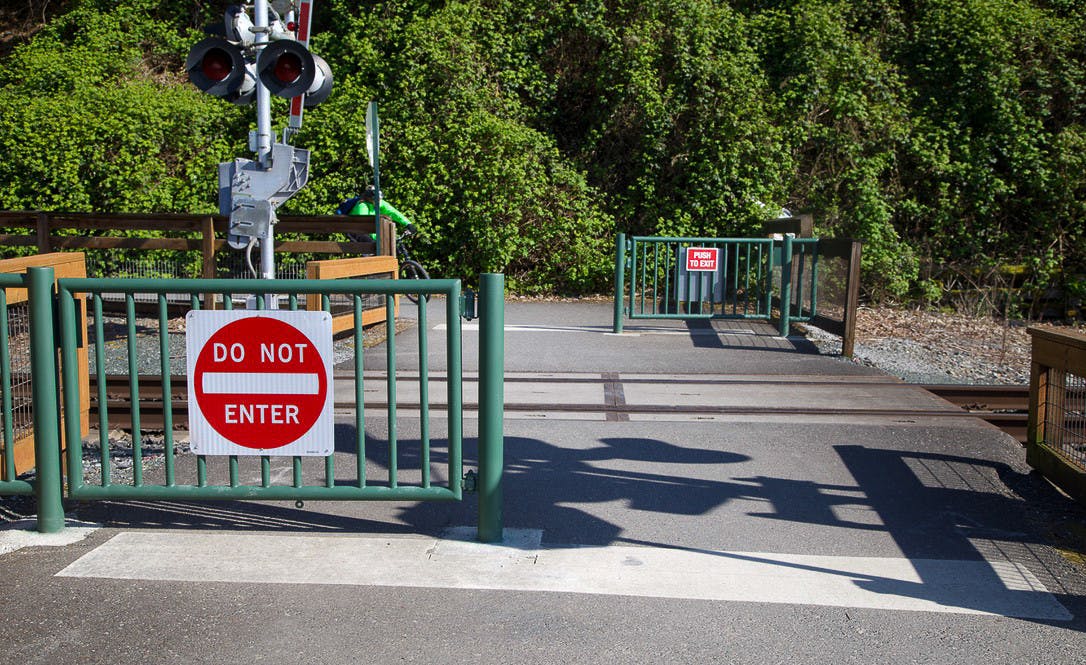It only takes a few hours in Bellingham to notice the sounds of trains rolling past. The minimum and maximum volume for train horns are regulated by the Federal Railroad Administration, which requires horns to sound at 96 dB to 110 dB – at its quietest, the sound is comparable to a power mower, and at its loudest, a live rock concert.
As of March 10, that concert has ended in Fairhaven. Five railroad crossings between Harris Avenue and Boulevard Park crossing were outfitted with the federally required safety upgrades necessary to consider a section of railroad a quiet zone. The City of Bellingham is now working on expanding the quiet zone up to the F Street crossing in the Lettered Streets neighborhood.
Quiet zones are stretches of railroad at least half a mile long where the Federal Railroad Administration has deemed train horns unnecessary. According to William Wong, the public affairs specialist for the Department of Transportation, to establish a quiet zone supplementary safety measures must be installed to compensate for the lack of train horns.
Supplementary safety measures include increased signage indicating the lack of train horn, quad gates with median dividers and traffic separators. Additional safety measures may be added based on accident history at a specific location, according to Wong.
“The City began the process of establishing quiet zones in Bellingham nearly two decades ago in response to concerns from residents and businesses about train horn noise,” said Stefanie Cilinceon, the public works communications and outreach coordinator for the City of Bellingham. “Reducing how often trains are required to sound their horns can make a real difference in daily life for those who live and work near the railroad tracks.”
Funding for quiet zones comes from both city and federal funding. Costs for the F Street crossing construction were covered by the Bellingham Transportation Fund and federal funds, Cilinceon said.

The pedestrian railroad crossing at Boulevard Park in Bellingham, Wash., on April 15, 2025. The new signs are part of the supplementary safety measures required to create a quiet zone. // Photo by Tori Lehman
Before the quiet zone was established, train horns would sound 24 hours a day. As train traffic has increased over the years, so have safety concerns for pedestrians and cyclists. The quiet zone has become a priority project for the City.
Residents like Bill Liddicoet, president of the Fairhaven Neighborhood Association, noticed the uptick in trains and appreciated the reprieve.
“Maybe there’d be one or two [trains] a day,” Liddicoet said. “Lately, until they stopped blowing, there’d be one or two an hour, blowing all day and all night. You’d have to hang up your phone call if one came by.”
The proximity of each crossing was also an annoyance for Liddicoet. The Federal Railroad Administration requires trains sound for 20 seconds prior to entering crossings in intervals of two long horns, one short horn and a final long horn. In locations like Fairhaven and the waterfront, crossings are as close as 500 feet, creating situations where horns blow almost immediately after passing a previous crossing.
“It feels like eight blasts in a row because by the time it's sounded its fourth horn at the first crossing, it’s already coming up on the second crossing,” Liddicoet said.
Some city residents on social media boards, like Reddit and Nextdoor, have raised safety concerns or remarked that the horns bring a charm to Bellingham. In emergencies, such as wildlife or pedestrians on the tracks, trains are still required to sound their horns even in quiet zones.
“Typically, crossing improvement projects improve the safety of vehicle, pedestrian and bike safety compared to pre-project conditions,” Cilinceon said in an email. “The recently installed emergency egress (exit) gates at the Boulevard Park crossing can make day-to-day use less convenient, but they provide for a fully secure intersection when trains go by while allowing for easy exit from the crossing by pedestrians and cyclists in the event that the gates close while a user is on the crossing.”

Egress gates added to the pedestrian crossing at Boulevard Park in Bellingham, Wash on April 15, 2025. The City of Bellingham said it provides fully secure pedestrian crossings at railroads. // Photo by Tori Lehman
For those living near the tracks, it’s not the new gates that intrude — it’s the music of the horns, less charming ballad and more sonic assault, Liddicoet said.
“I guess they could be kind of romantic, like a Johnny Cash tune, 'I hear the whistle blowing,'" Liddicoet said. "But not when it's blowing at 130 dB, eight times in a row, a quarter of a mile from your house. It's not romantic anymore."
The Pine Street crossing on the waterfront is currently in the design process. Once completed, it will go to a bidding stage where contractors can propose cost and timeline estimates for the project. The City will award a contract to the lowest bid.
The Pine Street crossing is open to bidding due to the size and needed budget for the construction. Bidding is expected to begin at the end of 2026.
Tori Lehman (she/her) is a city news reporter for The Front this quarter. Tori is in her third year at Western majoring in environmental journalism and minoring in women, gender, and sexuality studies. She enjoys immersing herself in nature and reading essays from authors like Joan Didion and Rayne Fisher-Quann in her spare time. You can reach her at torilehman.thefront@gmail.com.






